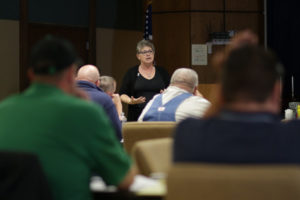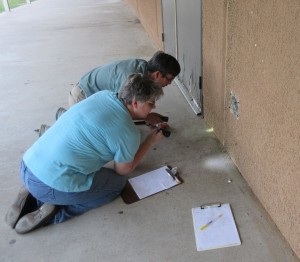Specialist created and continues to grow IPM programming around Texas
 Janet Hurley continues to be surprised by her career choice. She envisioned a job in health care, but despite fighting on a different front line, public health is still her focus.
Janet Hurley continues to be surprised by her career choice. She envisioned a job in health care, but despite fighting on a different front line, public health is still her focus.
Hurley, Texas A&M AgriLife Extension Service integrated pest management, IPM, program specialist, Dallas, was recently awarded the International Integrated Pest Management Award of Excellence for IPM Practitioner – Academic by the IPM Symposium for her outstanding work in school IPM.
The IPM Symposium is a 100% volunteer run group of practicing IPM professionals across the nation. The conference meets every three years, but due to COVID concerns, the 2021 conference is being put off and Hurley will have to wait until 2022 to officially receive her award.
Hurley was recognized for her efforts to establish and solidify Texas’ school IPM program. She was recognized by the IPM Symposium as one of the pioneers focused on school IPM education and program implementation at the school district level
“[Hurley] is a strong advocate of hands-on training, including field trips and demonstrations, and continues this approach in all educational events she organizes even today, such as the interactive Rodent Academy for schools and pest management professionals,” the award announcement read. “Through her successful program, Ms. Hurley has maintained regular training courses for school IPM coordinators and staff, hosted a nationally recognized school IPM website, served on national and regional school IPM committees, and established strong working relationships with a variety of organizations that have supported her school IPM efforts.”
Hurley recognized by IPM peers
In his nomination letter to the IPM Symposium, Mike Merchant, retired AgriLife Extension urban entomologist, Dallas, praised for Hurley’s continued efforts to make schools safer and train pest management professionals.

Janet Hurley, foreground, and Hoa Phan, Spring ISD, IPM coordinator investigate building for ants, image courtesy of Tom Green, IPM Institute of North America
“Janet Hurley’s job has always been a frontline, boots-on-the-ground position. She works tirelessly to learn and teach IPM,” Merchant wrote. “She is the glue that holds the Texas school IPM program together, keeping good records on contacts, remembering names and faces, and attending to the dozens of details that must be tracked for every training class. She has an almost encyclopedic knowledge of school districts and their IPM personnel. This serves her well in establishing the trust and relationships that encourage schools to adopt IPM.”
Hurley said being recognized as one of three recipients among hundreds of IPM specialists in the nation makes her feel she has made a difference in the profession and for her clients from Texas school districts, pest control professionals and ultimately the public.
Membership in the Symposium Steering Committee and participating in the conference are ideal for networking and sharing information among IPM professionals from around the nation, she said. It also allows collaboration with players involved in national programs like U.S. Department of Agriculture’s National Institute of Food and Agriculture and Animal and Plant Health Inspection Service.
“The conference is where we talk about new invasive species and cutting-edge integrated pest management tools and techniques,” she said. “So, for me, the symposium award is the highest recognition I could ever receive because it’s 100% from my peers.”
Hurley said it has taken a “village” – including AgriLife Extension specialists, various federal and state regulatory agencies and the school districts – to initiate and enforce an effective IPM program that focuses on protecting schools, students, and staff from pests and pesticides
“On our side, and the regulatory side, we want verifiable IPM within schools, and we work with school boards, administrators and facility managers regarding specific problems whether it’s proactive or dealing with infractions,” she said.
Leading the way in school IPM
In 1995, the Texas Legislature passed a law effectively creating pest management standards in school districts across the state, including mandated inspections. Hurley was hired in 2001 to oversee a U.S. Environmental Protection Agency grant to help promote school IPM through developing resources.
In 2002, the Legislative Budget Board’s mandated the Structural Pest Control Board, SPCB, to inspect 20% of the state’s 1,052 school districts each quarter that fiscal year. It was the first of its kind of regulatory inspection of school IPM rules in the nation.
Overnight, Hurley became someone school administrators and facility managers were seeking out and engaging. By summer 2002, the SPCB had completed 830 school IPM inspections of which 80% were non-compliant. This led Hurley to create the two-day school IPM coordinator training that is now recognized as a leading example of school IPM education.
Over time, school districts recognized the impact Hurley’s recommendations had on the way they fought pest problems, whether fire ants on campus, lice in a classroom or rats and roaches in storage and kitchen areas. They also recognized that budgeting properly and addressing problems proactively could save money in the long term.
Hurley’s goal as a specialist is to make recommendations based on scientific data and to establish best management practices with a focus on proactive measures that preempt the need for chemical control.
“Door sweeps would solve three-quarters of my problems,” she said. “Simple things like that. We are so engrained with the need for immediate gratification – ‘It comes in a can and kills bugs dead, so that’s what I will use.’ No, sometimes it’s not that simple, so my job has to be about changing that behavior and educating people about better, healthier, more cost-effective approaches to IPM.”
Making a difference
Hurley said she especially enjoys working with school districts because she has seen her efforts make a difference. But building and maintaining effective IPM programs in districts is an ongoing effort due to regulatory changes regarding treatment options, technology improvements and how specific pest populations ebb and flow if given an opportunity or build resistance.
There is also the loss of institutional knowledge due to turnover in districts. Hurley produces a monthly newsletter that is distributed nationally to 1,642 school staff members, pest management professionals and interested stakeholders to keep them informed about potential problems.
Each district is different and implements individual IPM plans, she said. But there are many standard practices all facility managers need to perform, such as preparations for summer and winter breaks, a time when pest problems can get out of control quickly.
Hurley said it’s important to recognize the efforts by school districts and their support staffs.
“It’s important to get recognition, but it’s also important to give the districts praise for their hard work,” he said. “Being a trusted resource, that is what sustains me. That and engaging with people around the state in a field I am passionate about and one that I believe makes a difference every day.”

 .
.